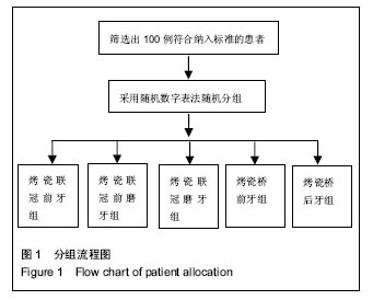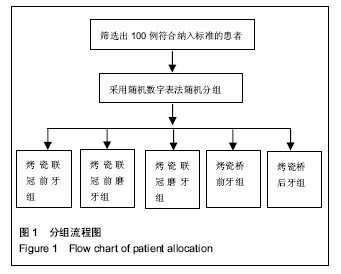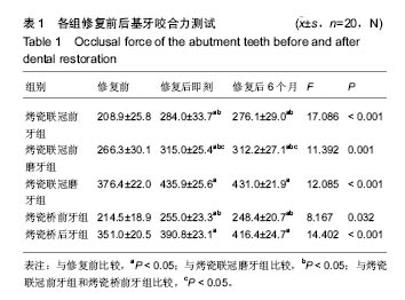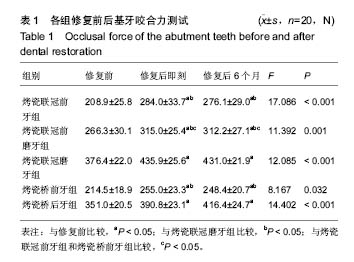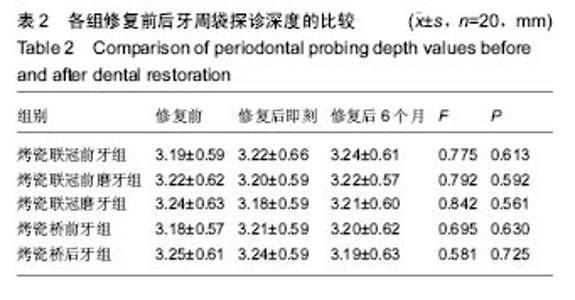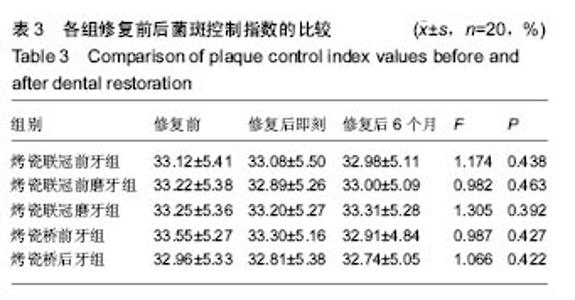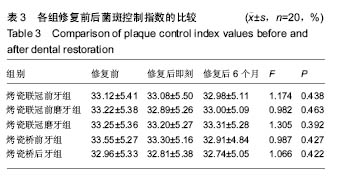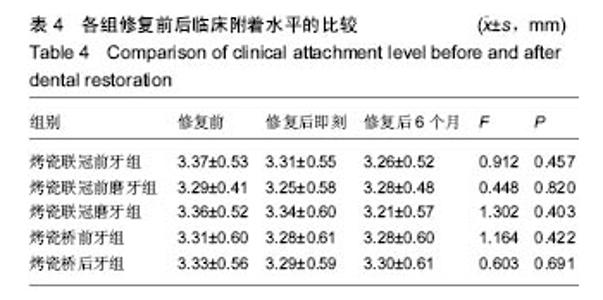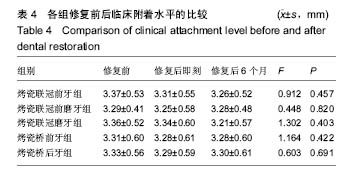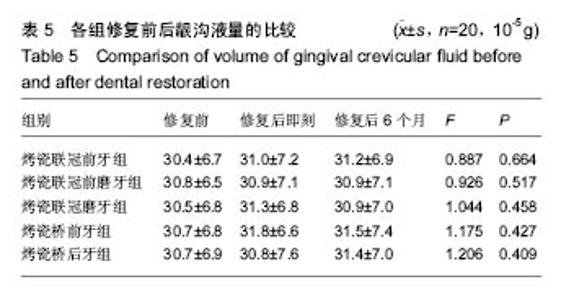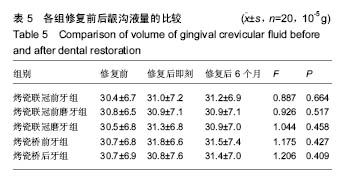| [1]黄会杰,陈贵丰.口腔种植修复与常规修复治疗牙列缺失的效果比较[J].广东医学,2016, 1(4):12-14.[2]商丽娟,吴岩,徐永军.CAD/CAM氧化锆全瓷冠修复对牙周组织的影响[J].中国组织工程研究, 2014,41(30):4804-4809.[3]刘靖.自锁托槽在伴有牙列缺失的轻中度牙周炎患者的临床应用效果观察[J].医学理论与实践,2014,4(2):155-156.[4]谭欢艳,宋乔健,张艳凤.玻璃纤维桩结合不同树脂核材料对残根残冠修复患者咀嚼功能及龈沟液炎症因子的影响[J].海南医学院学报,2015,21(2):113-115.[5]李艳丽,张大华,高玉文,等.全瓷冠与金属烤瓷冠在牙齿修复中的临床效果比较[J].中国现代药物应用,2015,6(15):111-112.[6]惠艳芳.全瓷冠与金属烤瓷冠在牙齿修复中的效果比较[J].心理医生,2015, 21(16):323-325.[7]Takahashi M,Yamaguchi S,Fujii T,et al.Contribution of each masticatory muscle to the bite force determined by MRI using a novel metal-free bite force gauge and an index of total muscle activity.J Magn Reson Imaging. 2016;44(4):804-813.[8]Boven GC,Raghoebar GM,Vissink A,et al.Improving masticatory performance, bite force, nutritional state and patient's satisfaction with implant overdentures: a systematic review of the literature.J Oral Rehabil.2015;42(3):220-233.[9]Iwasaki M,Yoshihara A,Sato N,et al.Maximum bite force at age 70 years predicts all-cause mortality during the following 13 years in Japanese men.JOral Rehabil. 2016;1(1):1-5.[10]Abreu RAMD,Pereira MD,Furtado F,et al.Masticatory efficiency and bite force in individuals with normal occlusion. Arch Oral Biol.2014;59(10):1065-1074.[11]Koyuncuoglu CZ,Metin S,Saylan I,et al.Full-mouth rehabilitation of a patient with ectodermal dysplasia with dental implants.J Oral Implantol.2014;40(6):714-721.[12]郭璇,李玉芳,马传杰.口腔修复治疗先天性缺牙的疗效探讨[J].中国美容医学,2014, 23(8):663-665.[13]陈建治,霍光,史月华,等. PBL在口腔修复学教学改革中的实践和探索[J]. 口腔颌面修复学杂志,2014,15(1):40-43.[14]高鹏元,贾平.医学美学在口腔修复中的应用探讨[J].中国美容医学,2014, 23(12):1005-1007.[15]黄文荣,刘柳芳,管宇.两种口腔纤维桩在口腔修复中的效果比较[J].中国医药科学,2014,21(1):199-200.[16]方絮,靳赢,高科北,等. 烤瓷牙修复对龈沟液内IL-23表达水平的影响[J].上海口腔医学, 2016,2(1):36-38.[17]李春库.金属烤瓷牙修复98例临床分析[J].中外女性健康研究, 2015,6(24):46-46.[18]吴国华.金属烤瓷牙修复的临床分析[J].全科口腔医学电子杂志, 2015,3(12):33-35.[19]储昊.烤瓷牙修复过程中对牙周组织保护的临床分析评价[J].现代诊断与治疗, 2014,6(10):54-55.[20]刘蕊.烤瓷牙修复的临床常见并发症分析及对策[J].临床医药文献电子杂志,2014, 1(8):1332-1333.[21]许占国.烤瓷牙修复常见并发症及对策分析[J].中国卫生标准管理,2015,6(15):24-25.[22]方宁,高玉录,瞿利军.金属烤瓷修复体对基牙龈沟液中酶水平影响的定量研究[J].医学美学美容旬刊,2015,3(2):68-68.[23]刘玉东.慢性牙周病治疗中金属烤瓷联冠的临床效果观察[J].医学美学美容旬刊, 2014,6(8):121-122.[24]徐树新,曹丹娜.玻璃纤维桩与铸造金属桩烤瓷牙修复残根残冠效果比较[J].中国乡村医药, 2014,4(16):41-42.[25]刘晓丹.慢性牙周病治疗中金属烤瓷联冠的临床效果观察[J].当代医学,2015, 21(23):41-42.[26]孙凤,张相嗥,刘峰,等.三种烤瓷桥临床修复六年的回顾分析[J].中华口腔医学杂志, 2008,43(4):199-202.[27]杨秋野,王丽杰,杨文香,等.90例金属烤瓷牙修复临床案例分析[J].中国伤残医学, 2014,5(4):24-25.[28]卢杨辉.前牙全瓷美学修复的体会[J].中国美容医学,2014,23(1): 62-62.[29]高思继.两种不同材料烤瓷冠边缘修复临床效果比较[J].中国农村卫生, 2014,6(10):63-64.[30]陈青楷.烤瓷牙修复的临床常见并发症分析及对策[J].中国社区医师,2014,6(18):75-75.[31]张洋.探讨镍铬烤瓷牙的临床应用和不良反应探讨[J].当代医学, 2015,7(11):84-85.[32]王鑫,张瑞.两种全冠修复方式对口腔面部美学影响的临床比较[J].中国医疗美容, 2015,8(4):93-94.[33]刘泉.烤瓷牙修复的常见临床问题分析[J].广西医学, 2005,27(2): 223-224.[34]王亚玲.烤瓷牙修复的临床常见并发症分析及对策[J].中国医学创新,2012, 9(15):21-22.[35]苗丽亚,艾红军.舌侧集中牙合与解剖式双侧平衡牙合全口义齿修复低平牙槽嵴无牙颌患者咀嚼效率及咬合力比较研究[J].中国实用口腔科杂志,2014,7(3):168-171.[36]肖严,熊康,权菲菲.不同咬合状态下上颌中切牙全瓷冠修复的有限元分析[J].中国组织工程研究,2016,20(12):24-26.[37]王蓉,徐欣.2种调(牙合)方法对后牙种植修复患者咬合平衡及咀嚼肌肌力的影响[J].上海口腔医学,2015,24(6):133-135.[38]张志燕.烤瓷联冠及烤瓷桥修复对基牙咬合力的影响[J].世界最新医学信息文摘:连续型电子期刊,2015,22(41):2304-2306.[39]孟繁荣,王晓冬,李卿. 烤瓷联冠及烤瓷桥修复后基牙咬合力变化情况分析[J].口腔颌面修复学杂志,2014,6(4):143-145.[40]王旭,杨晓东,艾红军.咬合力测试仪辅助治疗8例冠修复后颞下颌关节紊乱病临床分析[J]. 山西医药杂志, 2014,24(18): 2163-2164. |
